A Study of UVER in Santiago, Chile Based on Long-Term In Situ Measurements (Five Years) and Empirical Modelling
Abstact
1. Introduction
2. Materials and Methods
2.1. Study Area
2.2. Instruments and Satellite Data
2.3. Quality Control
2.4. Clearness Index
2.5. Erythema Indexes
2.6. Modelling Strategy
3. Results and Discussion
3.1. Seasonal Variation of UVER
3.1.1. Daily Values
3.1.2. Hourly Values
3.2. UVER Effects on Human Health
3.2.1. UVI and Sun Exposure Time
3.2.2. Erythemal Doses (SED and MED)
3.3. Development of Hourly and Daily Models
3.4. Model Validation
3.4.1. Hourly Values
3.4.2. Daily Values
3.5. Comparison with Other Sites
4. Conclusions
Author Contributions
Funding
Institutional Review Board Statement
Informed Consent Statement
Data Availability Statement
Acknowledgments
Conflicts of Interest
References
- Diffey, B.L. Solar ultraviolet radiation effects on biological systems. Phys. Med. Biol. 1991, 36, 299–328. [Google Scholar] [CrossRef]
- Andrady, A.; Hamid, S.; Hu, X.; Torikai, A. Effects of increased solar ultraviolet radiation on materials. J. Photochem. Photobiol. B Biol. 1998, 46, 96–103. [Google Scholar] [CrossRef]
- Caldwell, M.M.; Björn, L.; Bornman, J.F.; Flint, S.; Kulandaivelu, G.; Teramura, A.; Tevini, M. Effects of increased solar ultraviolet radiation on terrestrial ecosystems. J. Photochem. Photobiol. B Biol. 1998, 46, 40–52. [Google Scholar] [CrossRef]
- Ichihashi, M.; Ueda, M.; Budiyanto, A.; Bito, T.; Oka, M.; Fukunaga, M.; Tsuru, K.; Horikawa, T. UV-induced skin damage. Toxicology 2003, 189, 21–39. [Google Scholar] [CrossRef]
- Lucas, R.; McMichael, T.; Smith, W.; Armstrong, B. Solar Ultraviolet Radiation: Global Burden of Disease from Solar Ultraviolet Radiation; Annette Prüss-Üstün, H.Z., Colin Mathers, M.R., Eds.; World Health Organization: Geneva, Switzerland, 2006; Volume 55, ISBN 924 159440 3. [Google Scholar]
- Häder, D.-P.; Kumar, H.D.; Smith, R.C.; Worrest, R.C. Effects of solar UV radiation on aquatic ecosystems and interactions with climate change. Photochem. Photobiol. Sci. 2007, 6, 267–285. [Google Scholar] [CrossRef]
- Orient, J.M. Radiation and Human Health. JAMA 1982, 248, 1179–1180. [Google Scholar] [CrossRef]
- Häder, D.-P.; Williamson, C.E.; Wängberg, S.-Å.; Rautio, M.; Rose, K.C.; Gao, K.; Helbling, E.W.; Sinha, R.P.; Worrest, R. Effects of UV radiation on aquatic ecosystems and interactions with other environmental factors. Photochem. Photobiol. Sci. 2014, 14, 108–126. [Google Scholar] [CrossRef] [Green Version]
- Rivas, M.; Rojas, E.E.; Méndez, C.J.; Contreras, A.G. Dosis Eritémicas, Sobrexposición a la Radiación Solar Ultravioleta y Su Relación Con el Cáncer de Piel en Arica, Chile. Interciencia 2014, 39, 506–510. [Google Scholar]
- Correa, M.D.P.; Godin-Beekmann, S.; Haeffelin, M.; Bekki, S.; Saiag, P.; Badosa, J.; Jégou, F.; Pazmiño, A.; Mahé, E. Projected changes in clear-sky erythemal and vitamin D effective UV doses for Europe over the period 2006 to 2100. Photochem. Photobiol. Sci. 2013, 12, 1053. [Google Scholar] [CrossRef]
- Rivas, M.; Rojas, E.; Araya, M.C.; Calaf, G.M. Ultraviolet light exposure, skin cancer risk and vitamin D production. Oncol. Lett. 2015, 10, 2259–2264. [Google Scholar] [CrossRef] [Green Version]
- Correa, M.D.P.; Yamamoto, A.L.C.; Moraes, G.R.; Godin-Beekmann, S.; Mahé, E. Changes in the total ozone content over the period 2006 to 2100 and the effects on the erythemal and vitamin D effective UV doses for South America and Antarctica. Photochem. Photobiol. Sci. 2019, 18, 2931–2941. [Google Scholar] [CrossRef] [PubMed]
- Delcourt, C.; Boniol, M.; Carrière, I.; Delyfer, M.; Rougier, M.-B.; Le Goff, M.; Dartigues, J.-F.; Barberger-Gateau, P.; Korobelnik, J.-F.; Cougnard-Grégroire, A.; et al. Lifetime Exposure to Ambient Ultraviolet Radiation and the Risk for Cataract Extraction and Age-Related Macular Degeneration: The Alienor Study. Investig. Opthalmol. Vis. Sci. 2014, 55, 7619–7627. [Google Scholar] [CrossRef] [Green Version]
- Narayanan, D.L.; Saladi, R.N.; Fox, J.L. Review: Ultraviolet radiation and skin cancer. Int. J. Dermatol. 2010, 49, 978–986. [Google Scholar] [CrossRef] [PubMed]
- Rivas, M.; Rojas, E.; Calaf, G.M. Skin cancer risk affected by ultraviolet solar irradiance in Arica, Chile. Oncol. Lett. 2014, 7, 483–486. [Google Scholar] [CrossRef] [PubMed] [Green Version]
- McKinlay, A.F.; Diffey, B.L. A Reference Action Spectrum for Ultraviolet Induced Erythema in Human Skin. CIE J. 1987, 6, 17–22. [Google Scholar]
- Solano, F. Photoprotection and Skin Pigmentation: Melanin-Related Molecules and Some Other New Agents Obtained from Natural Sources. Molecules 2020, 25, 1537. [Google Scholar] [CrossRef] [Green Version]
- Brenner, M.; Hearing, V.J. The Protective Role of Melanin Against UV Damage in Human Skin. Photochem. Photobiol. 2007, 84, 539–549. [Google Scholar] [CrossRef] [Green Version]
- Fitzpatrick, T.B. The Validity and Practicality of Sun-Reactive Skin Types I Through VI. Arch. Dermatol. 1988, 124, 869–871. [Google Scholar] [CrossRef]
- World Health Organization; World Meteorological Organization. United Nations Environment Programm; International Commission on Non-Ionizing Radiation Protectio. Global Solar UV Index: A practical Guide. 2002, Volume 32. Available online: https://apps.who.int/iris/handle/10665/42459 (accessed on 1 March 2020).
- Utrillas, M.; Marín, M.J.; Esteve, A.; Salazar, G.; Suarez, H.; Castillo, J.; Martínez-Lozano, J. UVER and UV index at high altitude in Northwestern Argentina. J. Photochem. Photobiol. B Biol. 2016, 163, 290–295. [Google Scholar] [CrossRef]
- Sabatini-Ugarte, N.; Molgó, M.; Vial, G. Melanoma en Chile ¿Cuál es nuestra realidad? Rev. Med. Clin. Condes 2018, 29, 468–476. [Google Scholar] [CrossRef]
- Calaf, G.M.; Rivas, M.; Araya, M.C.; Caba, F.; Rojas, E. Ultraviolet light exposure influences skin cancer in association with latitude. Oncol. Rep. 2011, 25, 1153–1159. [Google Scholar] [CrossRef] [PubMed]
- Rivas, M.; Rojas, E.; Calaf, G.M.; Barberán, M.; Liberman, C.; Correa, M.D.P. Association between non-melanoma and melanoma skin cancer rates, vitamin D and latitude. Oncol. Lett. 2017, 13, 3787–3792. [Google Scholar] [CrossRef] [PubMed]
- Rivas, M.; Calaf, G.M.; Laroze, D.; Rojas, E.; Mendez, J.; Honeyman, J.; Araya, M.C. Solar ultraviolet A radiation and nonmelanoma skin cancer in Arica, Chile. J. Photochem. Photobiol. B Biol. 2020, 212, 112047. [Google Scholar] [CrossRef] [PubMed]
- Ministerio de Energía “Solar explorer”. Available online: http://solar.minenergia.cl/espectros (accessed on 1 January 2020).
- Dirección Metorológica de Chile, DMC. Available online: https://climatologia.meteochile.gob.cl/ (accessed on 1 January 2020).
- Universidad de Santiago de Chile, USACH. Available online: http://ambiente.usach.cl/uv/index.html (accessed on 1 January 2020).
- Zemelman, V.; Beck, V.; Petra, A.; Orlando, A.; Valenzuela, C.Y. Dimorfismo sexual en la pigmentación de la piel, color de ojos y pelo y presencia de pecas en adolescentes chilenos en dos estratos socioeconómicos. Rev. Med. Chile 2002, 130, 879–884. [Google Scholar] [CrossRef] [PubMed]
- Escobedo, J.F.; Gomes, E.N.; Oliveira, A.P.; Soares, J. Modeling hourly and daily fractions of UV, PAR and NIR to global solar radiation under various sky conditions at Botucatu, Brazil. Appl. Energy 2009, 86, 299–309. [Google Scholar] [CrossRef]
- Escobedo, J.F.; Gomes, E.N.; Oliveira, A.P.; Soares, J. Ratios of UV, PAR and NIR components to global solar radiation measured at Botucatu site in Brazil. Renew. Energy 2011, 36, 169–178. [Google Scholar] [CrossRef]
- Tereszchuk, K.A.; Rochon, Y.J.; McLinden, C.A.; Vaillancourt, P.A. Optimizing UV Index determination from broadband irradiances. Geosci. Model Dev. 2018, 11, 1093–1113. [Google Scholar] [CrossRef] [Green Version]
- Robaa, S.M. On the estimation of UV-B radiation over Egypt. Idojaras 2008, 112, 45–60. [Google Scholar]
- Kudish, A.; Evseev, E. Statistical relationships between solar UVB and UVA radiation and global radiation measurements at two sites in Israel. Int. J. Clim. 2000, 20, 759–770. [Google Scholar] [CrossRef]
- Kalogirou, S.; Pashiardis, S.; Pashiardi, A. Statistical analysis and inter-comparison of erythemal solar radiation for Athalassa and Larnaca, Cyprus. Renew. Energy 2017, 111, 580–597. [Google Scholar] [CrossRef]
- Utrillas, M.P.; Marín, M.J.; Esteve, A.R.; Salazar, G.A.; Suárez, H.; Gandía, S.; Lozano, J.A.M. Relationship between erythemal UV and broadband solar irradiation at high altitude in Northwestern Argentina. Energy 2018, 162, 136–147. [Google Scholar] [CrossRef]
- González-Rodríguez, L.; Rosas, J.; de Oliveira, A.P.; Rodríguez, L.; Contreras, D.; Baeza, C. Modeling of hourly and daily values of erythemal ultraviolet radiation in Santiago de Chile City. In Proceedings of the ISES Solar World Congress 2019 and IEA SHC International Conference on Solar Heating and Cooling for Buildings and Industry 2019, Santiago, Chile, 4–7 November 2019; pp. 2213–2222. [Google Scholar]
- Instituto Nacional de Estadísticas, INE. Available online: http://www.ine.cl (accessed on 15 January 2020).
- Gramsch, E.; Reyes, F.; Vásquez, Y.; Oyola, P.; Rubio, M.A. Prevalence of Freshly Generated Particles during Pollution Episodes in Santiago de Chile. Aerosol Air Qual. Res. 2016, 16, 2172–2185. [Google Scholar] [CrossRef] [Green Version]
- Rappenglück, B.; Oyola, P.; Olaeta, I.; Fabian, P. The Evolution of Photochemical Smog in the Metropolitan Area of Santiago de Chile. J. Appl. Meteorol. 2000, 39, 275–290. [Google Scholar] [CrossRef]
- Falvey, M.; Garreaud, R.D. Wintertime Precipitation Episodes in Central Chile: Associated Meteorological Conditions and Orographic Influences. J. Hydrometeorol. 2007, 8, 171–193. [Google Scholar] [CrossRef]
- Ministerio de Bienes Nacionales IDE Chile. infraestructura de datos Geoespaciales. Available online: http://www.ide.cl/ (accessed on 29 February 2020).
- Liu, B.Y.; Jordan, R.C. The interrelationship and characteristic distribution of direct, diffuse and total solar radiation. Sol. Energy 1960, 4, 1–19. [Google Scholar] [CrossRef]
- Reda, I.; Andreas, A. Solar position algorithm for solar radiation applications. Sol. Energy 2004, 76, 577–589. [Google Scholar] [CrossRef]
- Iqbal, M. An Introduction to Solar Radiation; Academic Press: Cambridge, MA, USA, 1983. [Google Scholar]
- Udo, S. Sky conditions at Ilorin as characterized by clearness index and relative sunshine. Sol. Energy 2000, 69, 45–53. [Google Scholar] [CrossRef]
- CIE; WMO. Rationalizing Nomenclature for UV Doses and Effects on Humans; CIE: Vienna, Austria, 2014; Available online: http://cie.co.at/publications/rationalizing-nomenclature-uv-doses-and-effects-humans (accessed on 2 March 2020).
- Fioletov, V.E.; Kerr, J.B.; Fergusson, A. The UV Index: Definition, Distribution and Factors Affecting It. Can. J. Public Health 2010, 101, I5–I9. [Google Scholar] [CrossRef]
- Zemelman, V.; Alvarado, C.; Valenzuela, V.B.P. Assessment of skin type, eye and hair color, freckles tendency in Chilean adolescents. J. Eur. Acad. Dermatol. Venereol. 1990, 12, 321. [Google Scholar]
- Furlan, C.; De Oliveira, A.P.; Soares, J.; Codato, G.; Escobedo, J.F. The role of clouds in improving the regression model for hourly values of diffuse solar radiation. Appl. Energy 2012, 92, 240–254. [Google Scholar] [CrossRef]
- Sharma, B.K. Environmental Chemistry; Publisher Krishna Prakashan Media: Delhi, India, 2014; ISBN 8182831199. [Google Scholar]
- Cordero, R.; Seckmeyer, G.; Damiani, A.; Jorquera, J.; Carrasco, J.F.; Muñoz, R.C.; Da Silva, L.; Labbé, F.; Laroze, D. Aerosol effects on the UV irradiance in Santiago de Chile. Atmospheric Res. 2014, 149, 282–291. [Google Scholar] [CrossRef]
- Silva, S.C.; Ipiña, A.; Damiani, A.; Cordero, R.R.; Piacentini, R.D. UV index values and trends in Santiago, Chile (33.5°S) based on ground and satellite data. J. Photochem. Photobiol. B Biol. 2012, 115, 73–84. [Google Scholar]
- Damiani, A.; Cabrera, S.; Muñoz, R.C.; Cordero, R.; Labbé, F. Satellite-derived UV irradiance for a region with complex morphology and meteorology: Comparison against ground measurements in Santiago de Chile. Int. J. Remote. Sens. 2013, 34, 5812–5833. [Google Scholar] [CrossRef]
- Rivas, M.; Rojas, E.; Cortés, J.; Santander, E. Efecto de la altura en la radiación solar ultravioleta en Arica norte de Chile. Revista Facultad de Ingeniería-Universidad de Tarapacá 2002, 10, 59–62. [Google Scholar]
- McKenzie, R.; Liley, B.; Björn, L.O. UV Radiation: Balancing Risks and Benefits. Photochem. Photobiol. 2009, 85, 88–98. [Google Scholar] [CrossRef] [PubMed]
- McKenzie, R.; Lucas, R.M. Reassessing Impacts of Extended Daily Exposure to Low Level Solar UV Radiation. Sci. Rep. 2018, 8, 1–5. [Google Scholar] [CrossRef] [PubMed]
- Lehmann, M.; Pfahlberg, A.B.; Sandmann, H.; Uter, W.; Gefeller, O. Public Health Messages Associated with Low UV Index Values Need Reconsideration. Int. J. Environ. Res. Public Health 2019, 16, 2067. [Google Scholar] [CrossRef] [Green Version]
- Ou-Yang, H.; Jiang, L.I.; Meyer, K.; Wang, S.Q.; Farberg, A.S.; Rigel, D.S. Sun Protection by Beach Umbrella vs Sunscreen With a High Sun Protection Factor: A Randomized Clinical Trial. JAMA Dermatol. 2017, 153, 304–308. [Google Scholar] [CrossRef]
- Vimercati, L.; De Maria, L.; Caputi, A.; Cannone, E.S.S.; Mansi, F.; Cavone, D.; Romita, P.; Argenziano, G.; Di Stefani, A.; Parodi, A.; et al. Non-Melanoma Skin Cancer in Outdoor Workers: A Study on Actinic Keratosis in Italian Navy Personnel. Int. J. Environ. Res. Public Health 2020, 17, 2321. [Google Scholar] [CrossRef] [Green Version]
- Cañada, J.; Pedros, G.; Bosca, J. Relationships between UV (0.290–0.385 μm) and broad band solar radiation hourly values in Valencia and Córdoba, Spain. Energy 2003, 28, 199–217. [Google Scholar] [CrossRef]
- Gandia, S.; Utrillas, M.P.; Gómez-Amo, J.L.; Esteve, A.R.; Estellés, V.; Pedrós, R.; Nuñez, J.A.; Lozano, J.A.M. Relationship between UVB and broadband solar radiation in Spain. Int. J. Clim. 2014, 35, 1761–1771. [Google Scholar] [CrossRef]
- Adam, M.E.-N. Determination of daily total ultraviolet-B in a subtropical region (Upper Egypt): An empirical approach. Atmos. Res. 2015, 153, 1–9. [Google Scholar] [CrossRef]
- Jacovides, C.; Tymvios, F.; Asimakopoulos, D.; Kaltsounides, N.; Theoharatos, G.; Tsitouri, M. Solar global UVB (280–315nm) and UVA (315–380 nm) radiant fluxes and their relationships with broadband global radiant flux at an eastern Mediterranean site. Agric. For. Meteorol. 2009, 149, 1188–1200. [Google Scholar] [CrossRef]
- Foyo-Moreno, I.; Alados, I.; Alados-Arboledas, L. Adaptation of an empirical model for erythemal ultraviolet irradiance. Ann. Geophys. 2007, 25, 1499–1508. [Google Scholar] [CrossRef]
- U.N.E.P. Environmental Effects and Interactions of Stratospheric Ozone Depletion, UV Radiation, and Climate Change. 2018. Available online: https://ozone.unep.org/science/assessment/eeap (accessed on 8 August 2020).
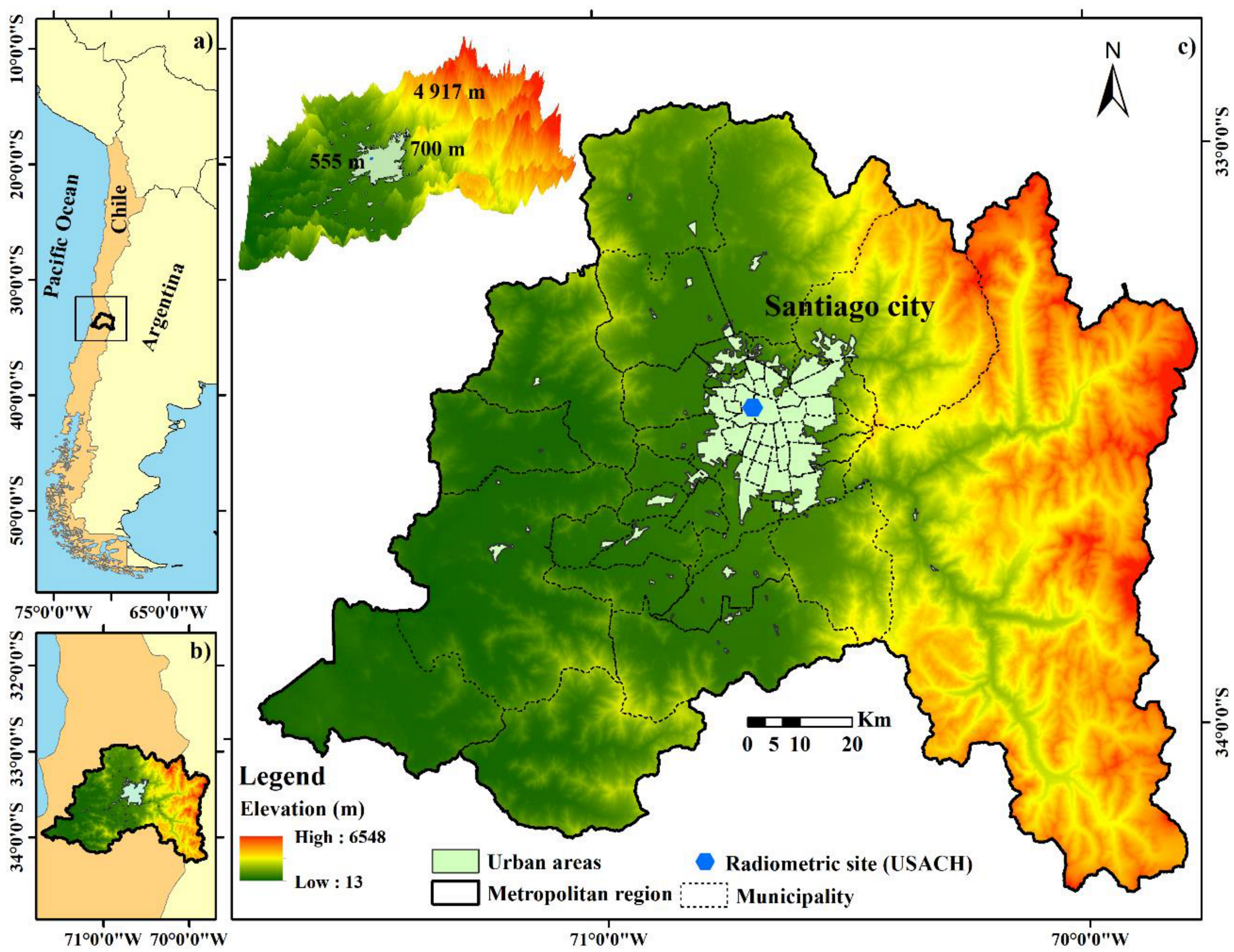
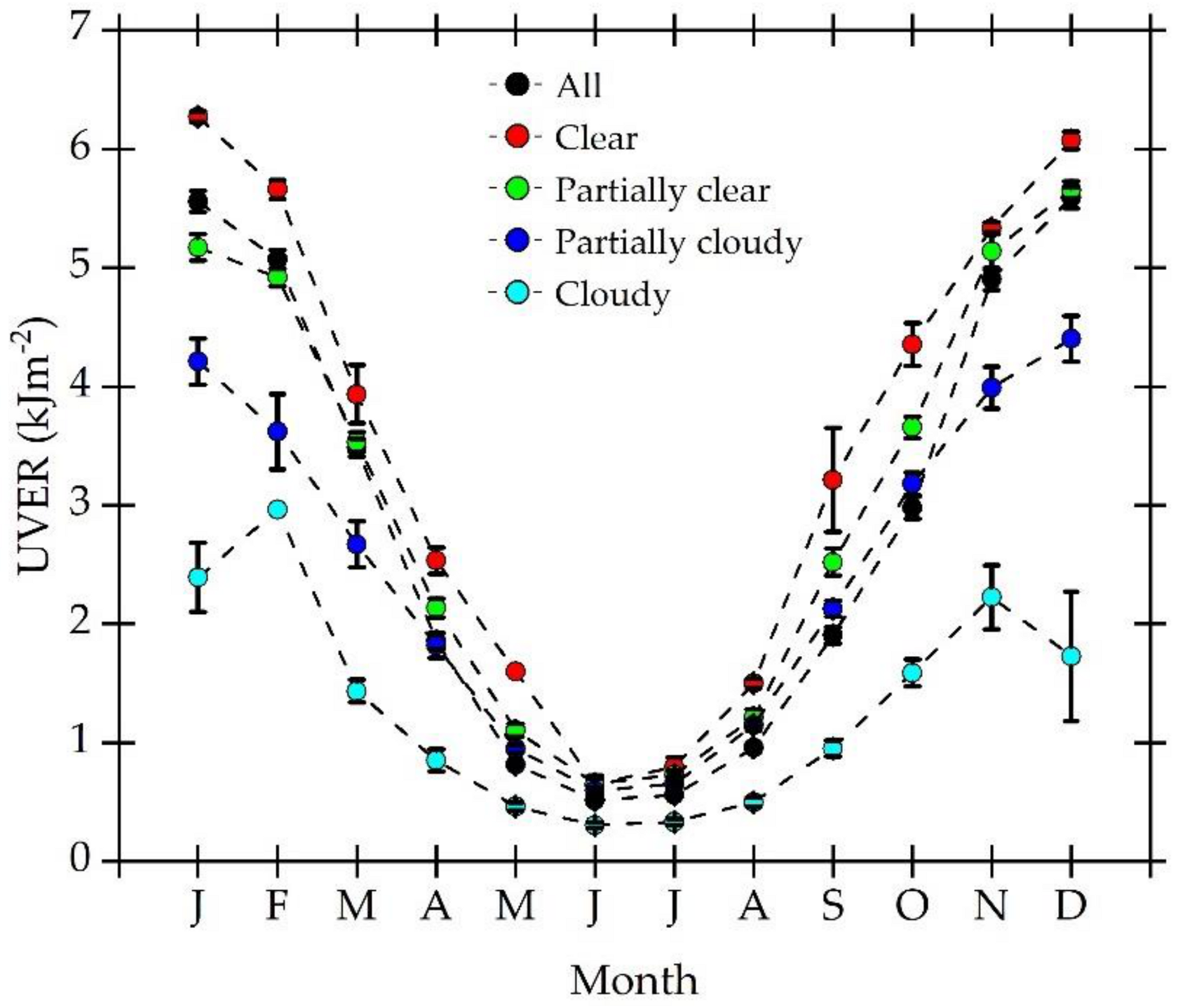
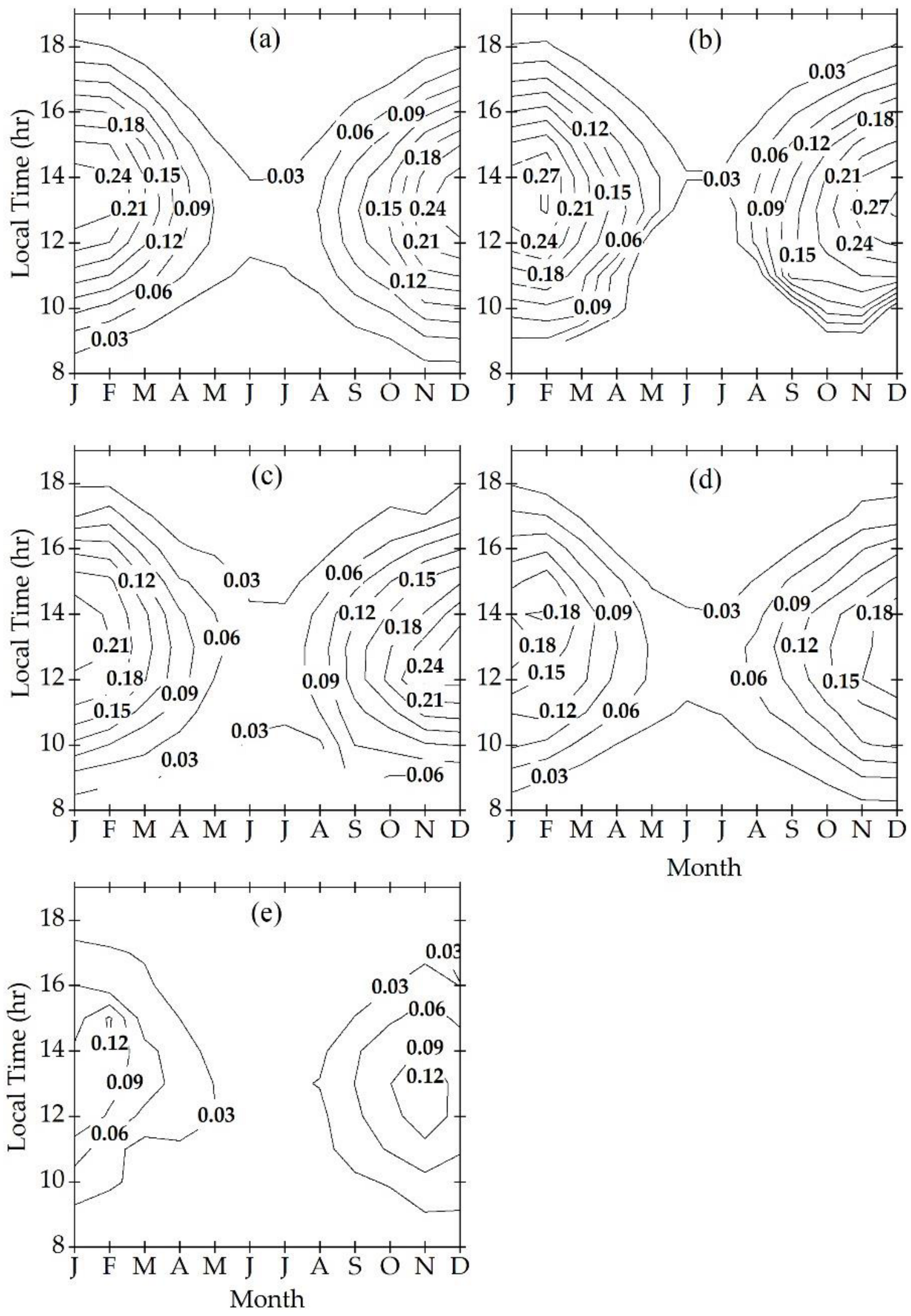
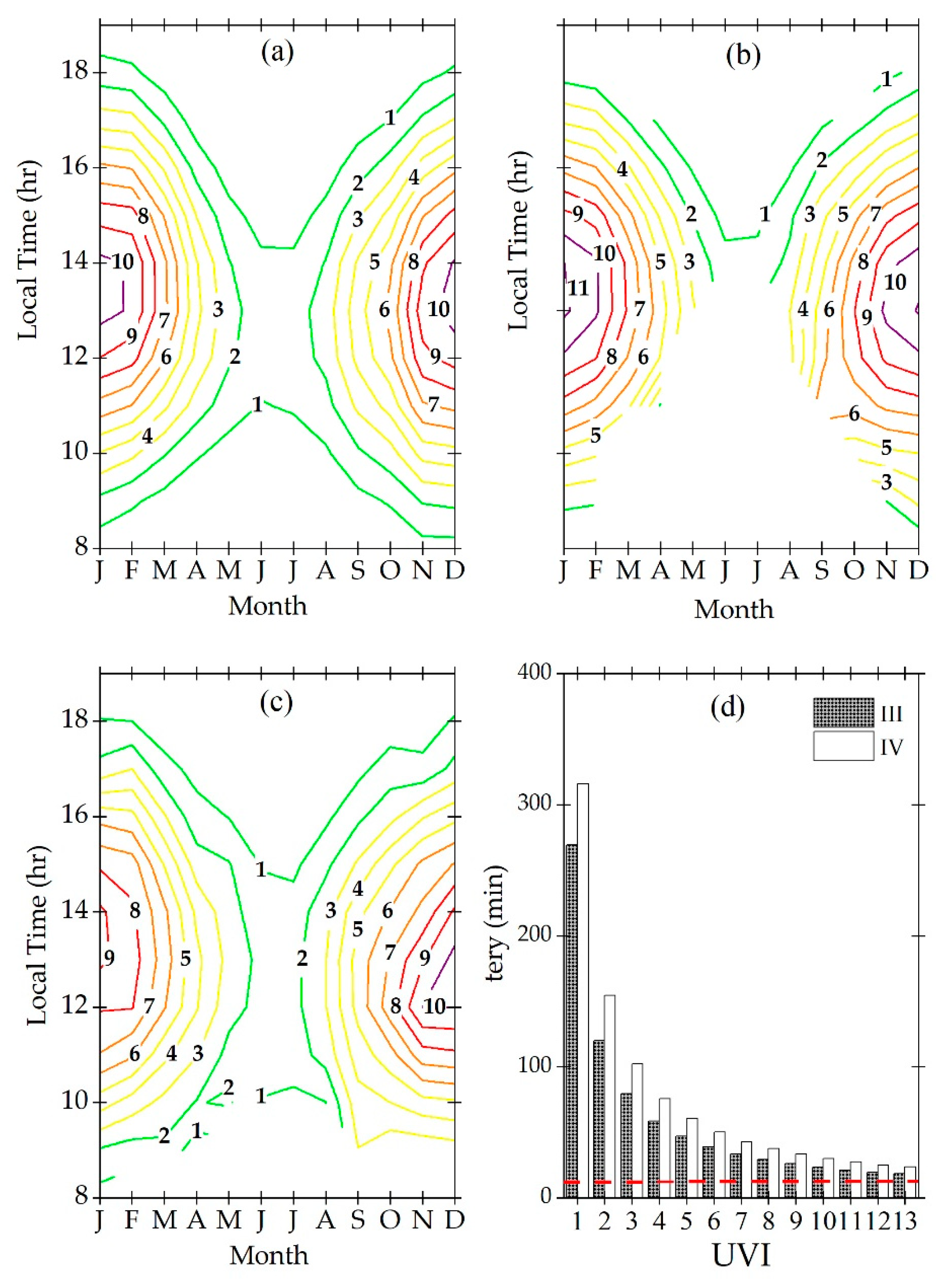
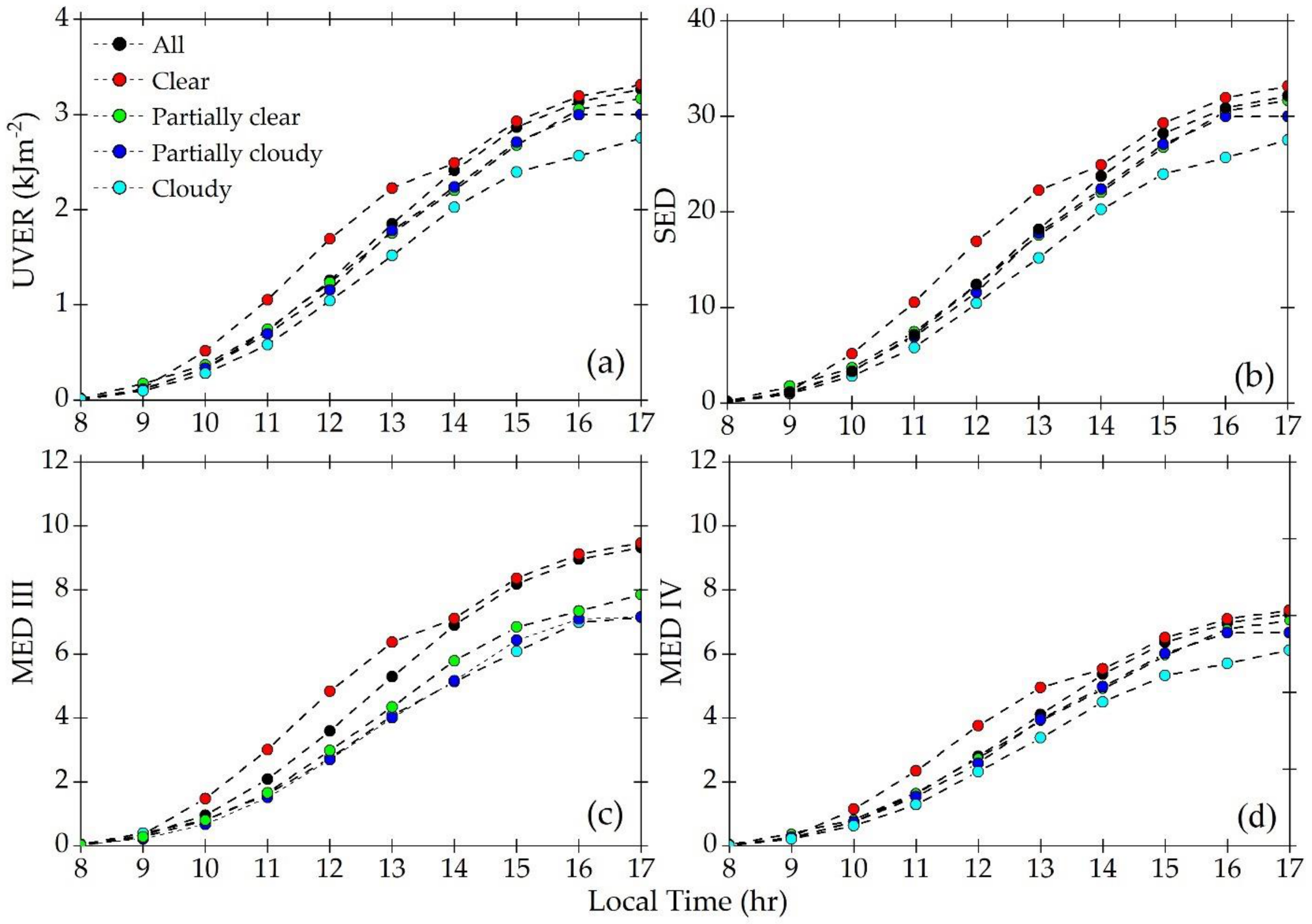
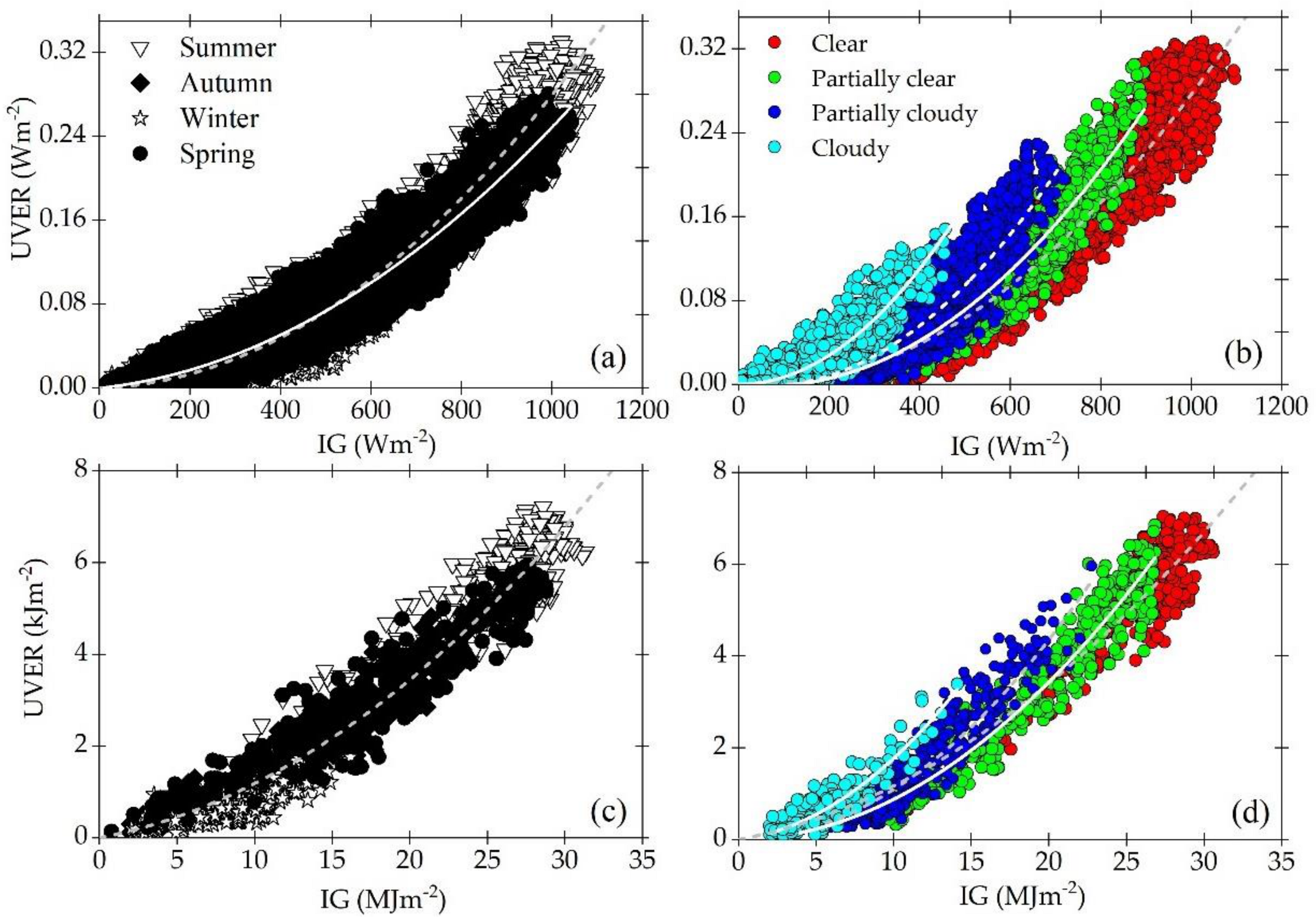
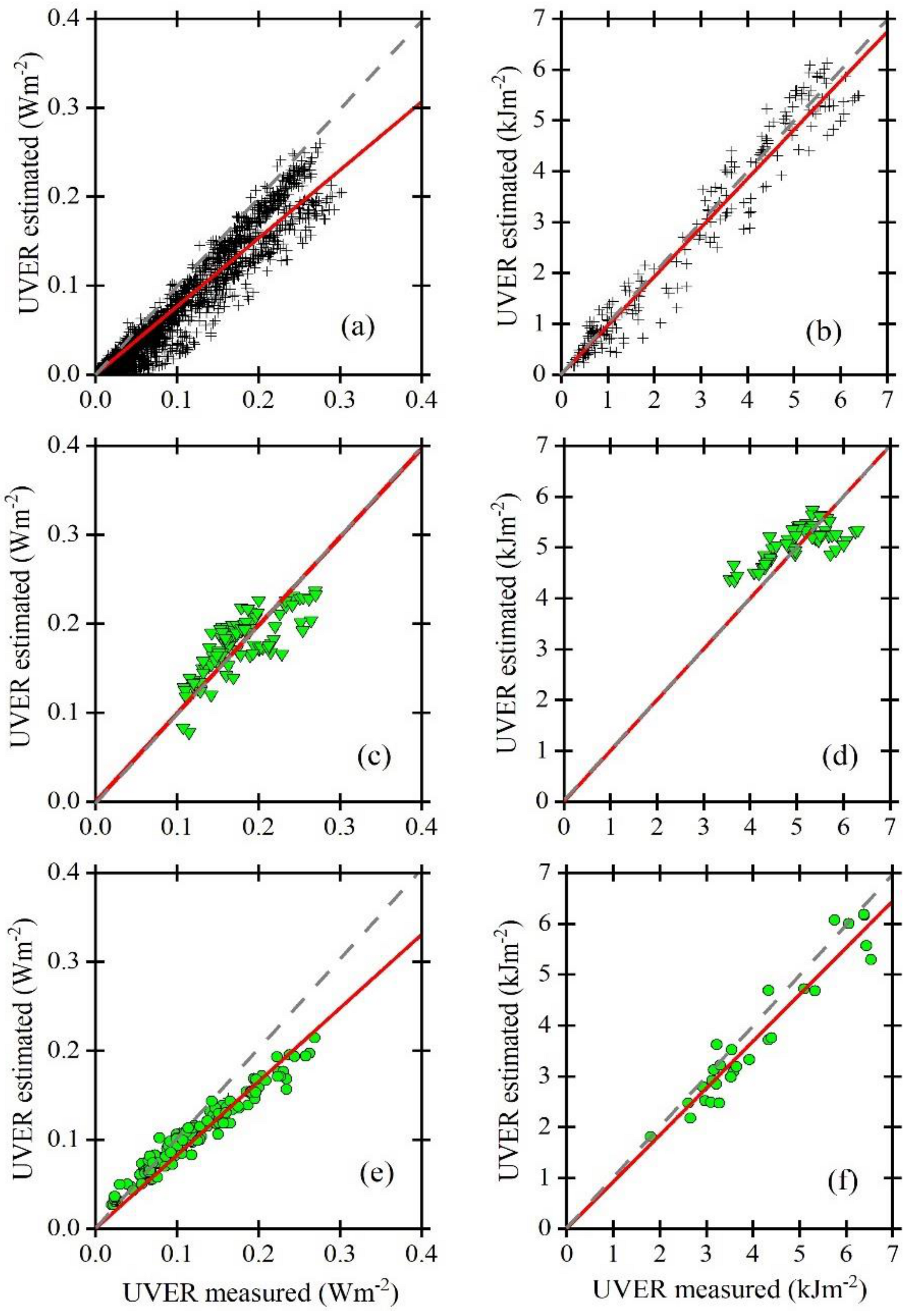
| Measurement | Year | Total | ||||
|---|---|---|---|---|---|---|
| 2015 | 2016 | 2017 | 2018 | 2019 | ||
| Hourly | 2593 | 3022 | 2631 | 2533 | 2461 | 13,011 |
| Daily | 333 | 346 | 339 | 328 | 228 | 1574 |
| Freq. Obs. (%) # | 91.2 | 94.5 | 92.9 | 89.9 | 62.5 | 86.2 |
| Month | UVER (kJm−2) | KTUVER | IG (MJm−2) | KT | CC A (%) | TOC (DU) | Day Length (h) | IGTOA (MJ m−2) |
|---|---|---|---|---|---|---|---|---|
| J | 5.56 ± 0.09 | 0.0204 ± 0.0003 | 25.30 ± 0.40 | 0.628 ± 0.009 | 52.4 ± 1.2 | 272.9 ± 0.8 | 13.724± 0.012 | 42.46 ± 0.05 |
| F | 5.07 ± 0.08 | 0.0201 ± 0.0003 | 23.93 ± 0.25 | 0.629 ± 0.006 | 51.0 ± 1.2 | 268.1 ± 0.9 | 13.055± 0.019 | 39.08 ± 0.11 |
| M | 3.48 ± 0.07 | 0.0162 ± 0.0003 | 19.69 ± 0.32 | 0.613 ± 0.009 | 52.6 ± 1.2 | 266.1 ± 1.1 | 12.159 ±0.023 | 33.29 ± 0.11 |
| A | 1.86 ± 0.07 | 0.0114 ± 0.0004 | 12.95 ± 0.40 | 0.515 ± 0.016 | 62.4 ± 1.6 | 264.8 ± 1.5 | 11.220± 0.021 | 26.38 ± 0.16 |
| M | 0.82 ± 0.03 | 0.0065 ± 0.0002 | 7.88 ± 0.25 | 0.410 ± 0.014 | 73.0 ± 1.4 | 271.4 ± 1.8 | 10.455± 0.014 | 20.81 ± 0.10 |
| J | 0.52 ± 0.02 | 0.0049 ± 0.0002 | 7.05 ± 0.22 | 0.424 ± 0.014 | 78.4 ± 1.2 | 281.9 ± 2.1 | 10.078± 0.003 | 18.25 ± 0.02 |
| J | 0.56 ± 0.02 | 0.0049 ± 0.0002 | 7.02 ± 0.22 | 0.411 ± 0.014 | 77.5 ± 1.1 | 286.8 ± 2.1 | 10.240± 0.010 | 19.28 ± 0.07 |
| A | 0.96 ± 0.04 | 0.0065 ± 0.0002 | 9.34 ± 0.29 | 0.420 ± 0.014 | 77.3 ± 1.2 | 293.8 ± 1.9 | 10.877± 0.019 | 23.62 ± 0.13 |
| S | 1.90 ± 0.07 | 0.0099 ± 0.0003 | 12.79 ± 0.40 | 0.434 ± 0.016 | 77.2 ± 0.9 | 310.7 ± 1.8 | 11.756± 0.022 | 29.82 ± 0.15 |
| O | 2.98 ± 0.09 | 0.0130 ± 0.0004 | 16.18 ± 0.49 | 0.462 ± 0.016 | 73.4 ± 1.2 | 309.2 ± 1.5 | 12.695± 0.022 | 36.02 ± 0.13 |
| N | 4.90 ± 0.09 | 0.0184 ± 0.0003 | 24.00 ± 0.48 | 0.601 ± 0.014 | 65.1 ± 1.3 | 298.4 ± 1.6 | 13.503± 0.015 | 40.63 ± 0.08 |
| D | 5.59 ± 0.09 | 0.0202 ± 0.0003 | 25.80 ± 0.36 | 0.619 ± 0.010 | 57.7 ± 1.2 | 281.0 ± 1.1 | 13.914± 0.004 | 42.89 ± 0.02 |
| mean | 2.84 ± 0.21 | 0.0127 ± 0.0001 | 15.99 ± 1.12 | 0.514 ± 0.038 | 65.9 ± 3.3 | 283.6 ± 4.8 | 11.973 ±0.405 | 31.04 ± 2.67 |
| Models | Hourly | Daily | ||||
|---|---|---|---|---|---|---|
| a (10−7) W−1m2 | b (10−5) | Number of Hours | a (10−3) MJ−1m2 | b (10−2) | Number of Days | |
| Season | ||||||
| Summer | 2.8 | 2.1 | 3860 | −1.0 | 24 | 344 |
| Autumn | 2.8 | 1.2 | 2307 | 5.5 | 6 | 338 |
| Winter | 1.9 | 2.9 | 1547 | 3.0 | 5 | 322 |
| Spring | 2.1 | 6.0 | 3065 | 2.5 | 13 | 342 |
| Sky condition | ||||||
| Cloudy | 7.4 | −0.7 | 2023 | 14.0 | 3.9 | 231 |
| Partially cloudy | 5.1 | −6.3 | 2513 | 10.8 | 0.3 | 417 |
| Partially clear | 3.8 | −4.8 | 1880 | 8.4 | 0.1 | 386 |
| Clear | 3.0 | −2.3 | 4363 | 5.2 | 6.9 | 312 |
| Interactions (Season + Sky condition) | ||||||
| Summer + Cloudy | 8.1 | −2.8 | 473 | - | - | - |
| Summer + Partially cloudy | 5.0 | −6.2 | 707 | −1.4 | 25 | 37 |
| Summer + Partially clear | 3.7 | −3.9 | 596 | 0.5 | 19 | 101 |
| Summer + Clear | 3.2 | −1.2 | 2084 | −2.5 | 28 | 200 |
| Autumn + Cloudy | 6.4 | −0.9 | 382 | 7.1 | 8 | 60 |
| Autumn + Partially cloudy | 4.5 | −4.1 | 503 | 6.3 | 6 | 93 |
| Autumn + Partially clear | 3.7 | −4.1 | 444 | 8.8 | −1.5 | 135 |
| Autumn + Clear | 3.1 | −0.6 | 978 | 8.3 | 7 | 53 |
| Winter + Cloudy | 2.8 | 4.1 | 438 | 6.5 | 5.5 | 101 |
| Winter + Partially cloudy | 3.2 | −0.5 | 536 | 9.0 | 0.1 | 165 |
| Winter + Partially clear | 3.2 | −4.2 | 354 | 5.0 | 1.9 | 58 |
| Winter + Clear | 2.4 | −3.7 | 219 | - | - | - |
| Spring + Cloudy | 8.1 | −0.2 | 730 | 3.3 | 14 | 69 |
| Spring + Partially cloudy | 5.1 | −6.2 | 767 | 7.4 | 7.4 | 114 |
| Spring + Partially clear | 2.9 | 0.5 | 486 | 9.4 | −1.5 | 77 |
| Spring + Clear | 3.2 | −3.7 | 1082 | 8.1 | −0.8 | 83 |
| General | ||||||
| All sky conditions | 2.5 | −2.0 | 10,779 | 5.2 | 7 | 1346 |
| Models | MBE (Wm−2) | RMSE (Wm−2) | NRMSE (%) | IA | MAPE (%) | Number of Hours |
|---|---|---|---|---|---|---|
| Season | ||||||
| Summer | 0.001 | 0.024 | 15.8 | 0.98 | 14.07 | 622 |
| Autumn | 0.000 | 0.014 | 30.1 | 0.98 | 30.39 | 379 |
| Winter | 0.006 | 0.011 | 55.8 | 0.92 | 36.51 | 787 |
| Spring | 0.016 | 0.030 | 36.7 | 0.95 | 59.60 | |
| Sky conditions | 694 | |||||
| Clear | 0.001 | 0.025 | 14.1 | 0.96 | 13.67 | 457 |
| Partially clear | 0.008 | 0.021 | 17.6 | 0.97 | 13.48 | 443 |
| Partially cloudy | 0.002 | 0.019 | 34.6 | 0.95 | 24.83 | 631 |
| Cloudy | 0.002 | 0.010 | 74.6 | 0.94 | 41.86 | |
| Interactions (Season + Sky conditions) | 951 | |||||
| Summer + Clear | 0.018 | 0.023 | 13.2 | 0.97 | 15.78 | 320 |
| Summer + Partially clear | 0.002 | 0.025 | 14.6 | 0.92 | 12.82 | 110 |
| Summer + Partially cloudy | 0.006 | 0.023 | 26.9 | 0.91 | 18.99 | 131 |
| Summer + Cloudy | 0.001 | 0.016 | 63.2 | 0.91 | 49.46 | 72 |
| Autumn + Clear | 0.016 | 0.022 | 21.5 | 0.93 | 34.83 | 71 |
| Autumn + Partially clear | −0.001 | 0.013 | 17.4 | 0.98 | 14.46 | 85 |
| Autumn + Partially cloudy | −0.002 | 0.014 | 37.2 | 0.95 | 26.91 | 79 |
| Autumn + Cloudy | −0.001 | 0.008 | 80.1 | 0.90 | 42.61 | 144 |
| Winter + Clear | - | - | - | - | - | - |
| Winter + Partially clear | −0.015 | 0.018 | 31.5 | 0.72 | 24.46 | 92 |
| Winter + Partially cloudy | −0.007 | 0.012 | 35.6 | 0.89 | 25.51 | 228 |
| Winter + Cloudy | −0.002 | 0.006 | 79.3 | 0.86 | 38.14 | 456 |
| Spring + Clear | −0.041 | 0.046 | 25.7 | 0.83 | 22.90 | 118 |
| Spring + Partially clear | −0.017 | 0.029 | 23.3 | 0.92 | 15.29 | 156 |
| Spring + Partially cloudy | −0.010 | 0.022 | 35.0 | 0.94 | 26.20 | 152 |
| Spring + Cloudy | −0.002 | 0.011 | 52.6 | 0.96 | 40.84 | |
| General | 259 | |||||
| All sky conditions | −0.021 | 0.032 | 42.9 | 0.95 | 41.18 | 2482 |
| Conditions | MBE (kJm−2) | RMSE (kJm−2) | NRMSE (%) | IA | MAPE (%) | Number of Days |
|---|---|---|---|---|---|---|
| Season | ||||||
| Summer | 0.360 | 0.651 | 13.2 | 0.89 | 14.06 | 73 |
| Autumn | −0.016 | 0.185 | 10.9 | 0.99 | 16.83 | 27 |
| Winter | −0.099 | 0.210 | 17.2 | 0.92 | 21.72 | 65 |
| Spring | −0.423 | 0.738 | 22.7 | 0.93 | 17.31 | 63 |
| Sky condition | ||||||
| Clear | 0.097 | 1.024 | 17.7 | 0.20 | 13.15 | 8 |
| Partially clear | 0.095 | 0.586 | 12.8 | 0.94 | 10.57 | 95 |
| Partially cloudy | −0.031 | 0.432 | 23.4 | 0.97 | 18.85 | 76 |
| Cloudy | −0.015 | 0.334 | 37.4 | 0.92 | 23.21 | 49 |
| Interactions (Season + Sky condition) | ||||||
| Summer + Clear | −0.423 | 0.548 | 9.7 | 0.14 | 8.65 | 7 |
| Summer + Partially clear | −0.060 | 0.505 | 10.0 | 0.73 | 8.48 | 57 |
| Summer + Partially cloudy | −0.521 | 0.969 | 24.4 | 0.79 | 37.23 | 7 |
| Summer + Cloudy | - | - | - | - | - | 2 |
| Autumn + Clear | - | - | - | - | - | - |
| Autumn + Partially clear | −0.100 | 0.272 | 8.6 | 0.96 | 7.44 | 10 |
| Autumn + Partially cloudy | −0.146 | 0.209 | 19.6 | 0.93 | 18.56 | 9 |
| Autumn + Cloudy | 0.010 | 0.110 | 18.4 | 0.91 | 14.23 | 8 |
| Winter + Clear | - | - | - | - | - | - |
| Winter + Partially clear | - | - | - | - | - | - |
| Winter + Partially cloudy | 0.253 | 0.330 | 32.2 | 0.77 | 26.21 | 40 |
| Winter + Cloudy | 0.119 | 0.164 | 31.3 | 0.81 | 23.28 | 25 |
| Spring + Clear | - | - | - | - | - | 1 |
| Spring + Partially clear | 0.332 | 0.498 | 12.2 | 0.97 | 11.68 | 28 |
| Spring + Partially cloudy | −0.041 | 0.465 | 14.9 | 0.94 | 15.46 | 20 |
| Spring + Cloudy | 0.282 | 0.439 | 28.2 | 0.88 | 22.42 | 14 |
| General | ||||||
| All sky conditions | −0.136 | 0.539 | 18.5 | 0.98 | 16.74 | 228 |
| Season | ||
|---|---|---|
| Hourly | Daily | |
| Summer | −2.8 | 1.2 |
| Autumn | −1.1 | 14.7 |
| Winter | −1.0 | 0.5 |
| Spring | −3.1 | −56.8 |
| Annual | −2.0 | −13.6 |
| Site | Latitude, Longitude | Land Use | Altitude (m asl) | Model | Coefficients | R2 | |
|---|---|---|---|---|---|---|---|
| a | b | ||||||
| Santiago, Chile | 33°30′ S, 70°42′ W | urban | 520 | Hourly | 2.5 × 10−7 | −2.0 × 10−5 | 0.97 |
| Daily | 5.2 × 10−3 | 7.0 × 10−2 | 0.98 | ||||
| Larnaca, Cyprus # | 34°87′ N, 33°63′ E | rural | 1 | Hourly | 1.0 × 10−7 | 17.0 × 10−5 | 0.96 |
| Daily | 2.6 × 10−3 | 5.9 × 10−2 | 0.96 | ||||
| Athalasa, Cyprus # | 35°15′ N, 33°40′ E | semi-rural | 165 | Hourly | 0.1 × 10−7 | 1.6 × 10−5 | 0.95 |
| Daily | 3.6 × 10−3 | 8.3 × 10−2 | 0.96 | ||||
Publisher’s Note: MDPI stays neutral with regard to jurisdictional claims in published maps and institutional affiliations. |
© 2021 by the authors. Licensee MDPI, Basel, Switzerland. This article is an open access article distributed under the terms and conditions of the Creative Commons Attribution (CC BY) license (http://creativecommons.org/licenses/by/4.0/).
Share and Cite
González-Rodríguez, L.; de Oliveira, A.P.; Rodríguez-López, L.; Rosas, J.; Contreras, D.; Baeza, A.C. A Study of UVER in Santiago, Chile Based on Long-Term In Situ Measurements (Five Years) and Empirical Modelling. Energies 2021, 14, 368. https://doi.org/10.3390/en14020368
González-Rodríguez L, de Oliveira AP, Rodríguez-López L, Rosas J, Contreras D, Baeza AC. A Study of UVER in Santiago, Chile Based on Long-Term In Situ Measurements (Five Years) and Empirical Modelling. Energies. 2021; 14(2):368. https://doi.org/10.3390/en14020368
Chicago/Turabian StyleGonzález-Rodríguez, Lisdelys, Amauri Pereira de Oliveira, Lien Rodríguez-López, Jorge Rosas, David Contreras, and Ana Carolina Baeza. 2021. "A Study of UVER in Santiago, Chile Based on Long-Term In Situ Measurements (Five Years) and Empirical Modelling" Energies 14, no. 2: 368. https://doi.org/10.3390/en14020368
APA StyleGonzález-Rodríguez, L., de Oliveira, A. P., Rodríguez-López, L., Rosas, J., Contreras, D., & Baeza, A. C. (2021). A Study of UVER in Santiago, Chile Based on Long-Term In Situ Measurements (Five Years) and Empirical Modelling. Energies, 14(2), 368. https://doi.org/10.3390/en14020368







